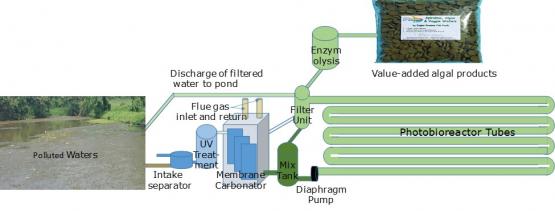
Watersheds and numerous bodies of water in the midwestern U.S. are contaminated with waste phosphorous and nitrogen. A direct result of this contamination is summer-time hazardous algal (cyanobacterial) blooms that often result in the release of cyanotoxins, which make the water undrinkable, and unusable for irrigation and recreation. The problem is so significant that numerous states and the USEPA are seeking solutions from a number of sectors. Algal-based water remediation technology has been successfully employed to polish phosphorous at municipal wastewater treatment plants. However, remediating water contaminated with biological species, organic waste, and other contaminants poses a significant challenge to the widespread use of algal remediation.

Working with Honda R&D Americas, Ohio University is developing technology to integrate algal remediation of polluted waters with CO2 recycling. Using a combination of filtration technologies, algal bioreactor design, carbon mass-transfer enhancements, and post-processing methods, our team aims to reduce the cost of contaminated water remediation while reducing greenhouse gas emission and producing a product (algal biomass) that may have economic value in separated products such a proteins, lipids, and free fatty acids. If successful, the combination of these technologies might offer a cost-effective, distributed method for on-site water remediation to reduce overall watershed contamination.
In developing this wastewater technology, Ohio University has also developed a catalytic membrane system (Membrane Carbonator) for enhanced inorganic cabon infusion into media for commercial phototrophic algae production. Because CO2 in air is ubiquitous, deployment of this system can be nearly universal, providing a reliable and robust supply of inorganic carbon, freeing algal producers to develop sites without the constraints of access to CO 2 .
Advantages
Algal Wastewater Treatment
- Reduction in nutrient runoff and watershed eutrophication
- Promoted carbon recycling and reduction of greenhouse gas emissions
- Results in products that have economic value instead of additional waste
Membrane Carbonator
- Employ substrate vertical film flow with catalytic conversion that provides inorganic carbon from air at rates supporting > 50 g/m 2 /day of algal productivity
- Film flow over vertical substrates reduces liquid side mass transfer resistance and increases CO 2 transfer from air by more than 20x simple diffusion.
- Catalysts promote conversion of CO 2 to H 2 CO 3 , further increasing the mass transfer potential
- Lowers operational and total cost of inorganic carbon for phototrophic algal growth to enhance commercially viability
- Better pH control and culture stability by avoiding sparging
- Increase siting flexibility through robust supply of CO 2 from air without need for flue gas or for tanks
- Scalable technology for large or small algae producers
Literature
- Bayless, D.J. (2018). Method and system for enhancing the mass transfer rate of a soluble gas, U.S. Patent No. 9,908,777.
Technology Readiness Level
- Algal Wastewater Processing – TRL 3
- Membrane Carbonator – TRL 3
Current Investigators
- Ahmad Abu Hajer, Graduate Student
- Ed Drabold, Undergraduate Student
- Shoghik Dilanyan, Undergraduate Student
Sponsors
- Ohio Water Development Authority
- Honda R&D Americas
- Ohio Third Frontier
- U.S. Department of Energy
Press
- Honda R&D Americas (2018), Farming Honda’s Future
